Musgrove Mill Golf Club, SC
by Tom Williamsen
History
An Arnold Palmer Signature course, Musgrove Mill has a unique layout, with each hole providing a different and memorable experience. The changing elevations add interest, different perspectives and, importantly, variety to shot selection. As testimony to the quality of the course design, Musgrove Mill is consistently ranked in Golfweek’s “100 Best Modern Courses in America.”
Once the site of a Revolutionary War battle, the course is now the site of numerous golf battles. Musgrove Mill has hosted almost every South Carolina Golf Association event, including the State Amateur, Mid-Amateur and Four-ball championships, as well as the PGA South Carolina Open. On the regional level, Musgrove is also a frequent host for the Carolinas (North and South Carolina) Amateur and Mid-Amateur.
The Enoree River comes into play on a number of holes. The river and other associated aspects of this wetlands habitat all add up to a unique golf experience. Most notably is the fact that there are NO homes on or even near the course. There is also no construction noise, no neighborhood or traffic sounds. It’s just birdies and birds living in harmony. Members often report seeing wild turkeys and deer on the course.
Actually three architects contributed to the cause. Tom Fazio is responsible for some of the routing. Palmer did the majority of the work and is given credit for the design. Because of his friendship with the first head pro, Palmer gave the project a lot of personal on-site time. Ken Tomlinson did much of the construction and made some changes as well. It was a case of many cooks making the stew great. I dare anyone to play it and come up with the name of the architect. It is unlike anything you may have played and it certainly is unlike anything Palmer has designed.
Opening in 1988, the course measures 6933 yards, plays to par 72 and a slope of 147. The course is about excitement and imagination. The rolling terrain is stunning and the 330 acres of turkeys, deer, and assorted wildfowl give a feeling of splendid isolation. Musgrove doesn’t slap you around as much as it seduces you into her web of horrors. A double bogey is always lurking about to snare an errant shot. It has the reputation of being one of the toughest tests of golf in South Carolina. The members do not apologize for its difficulty but rather cherish the challenge. The course features broad corridors off the tee, sandy waste areas, natural vegetation, marshland, stunning greens complexes, and fast treacherous putting surfaces. An architect’s job is to use the land as well as can be done and keep you in touch with nature. Palmer certainly achieved it at Musgrove. Playing it for the first time suspend any preconceived notion of what you might expect. Nothing can prepare you for the experience you are about to have. Unique is an over used word but unique it is. This is target golf at its best. It looks more intimidating than it really is; consequently, local knowledge is important. To score well you need precise iron play, a good short game, and a deft putting touch.
The Club
Musgrove Mill is truly a golfers club. It boasts a high percentage of single digit handicappers and some of the state’s elite amateurs are club members. We who are lucky enough to be members value what we have and are fiercely loyal to the club. There is a large national membership (including me) that visits two or three times a year. We will bring up to seven guests and stay in one of the cottages. Will Holroyd, the course superintendent, always has the course in excellent condition to play fast and firm. The fairways and rough are Bermuda and the slick greens are bent. The course only gets about 12,000 rounds a year consequently starting times are unnecessary. It is truly a home away from home. Head Pro Jeff Tallman makes everyone feel welcome. It is the only place I go where the general manager, Barbara Long, actually gives me a hug. In the morning I will wander into the kitchen and pour myself a cup of coffee and in the evening the staff will bring dinner to the cottage. I have yet to bring a guest who does not want to return time after time or grow tired of the course.
It is a good idea to frequent the short game area. At Musgrove a good short game can save a lot of weeping and gnashing of teeth. The practice area gives you the opportunity to play from various kinds of lies: fairway, hard pan, long grass, bunkers, and sandy waste area. You can hit a variety of shots from 150 yards in to two large sculpted greens. It is designed in such a way that nine players can practice at the same time. Because the short game area is on the back of the driving range you can actually hit a three wood out of a bunker.
Hole 1 403/366 yards par 4: The first hole gets you off to a relatively benign start. The tee ball needs to clear a sandy waste area to land on the generous fairway. A good drive will leave a short iron into a green that slopes from right to left. It is a good place to make a birdie and get off to a successful start.

View of the first green from the fairway.
Hole 2 140/121 yards par 3: The second hole is a drop shot par three with an elevation change of about forty feet. Standing on the tee you think birdie, but there is so much that can go wrong on the trip that trundles down the hill that three makes you happy. The green has a creek on three sides and a sandy waste area on the right. A good target is the center of this small green.
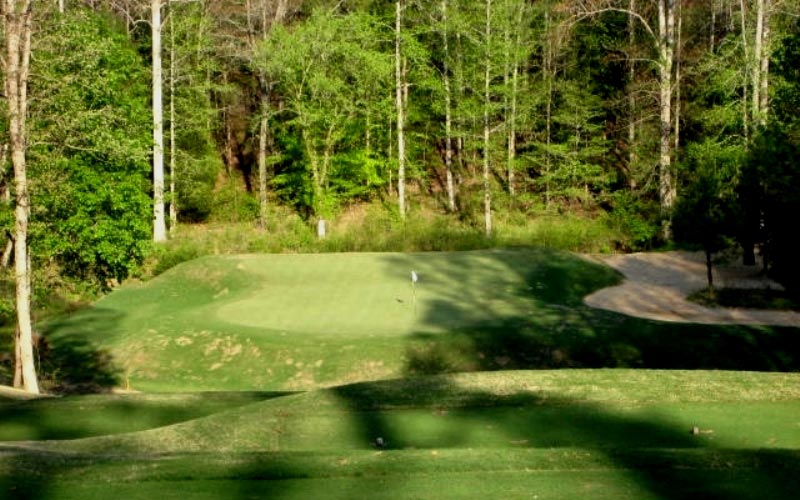
The picturesque second where distance judgement is tricky.
Hole 3 546/521 yards par 5: The third hole offers a number of options. The fairway is fifty yards wide but hit the drive down the left side and a little hillock will give you some extra roll. The hole is reachable for longer hitters but the shallow green needs to be hit on the fly. A large waste area fronting the green extends a hundred and fifty yards down the right side of the fairway. A lay up on the left side of the fairway gives you the best angle into this canted green. You have a good chance for a birdie here.
Hole 4 458/426 yards par 4:
The first three holes get you warmed up. The course really begins at number four. If I am over par coming into this hole I know I am in for long day. This hole is a meandering dogleg to the right. The tee shot is relatively innocuous but the best line hugs the right side near a creek that weaves along the fairway until it gets close to the green where it runs diagonally in front of the green. The difficulty lies in getting to the green in regulation. Once there, the large green undulates gently. The second shot is the key to the hole.
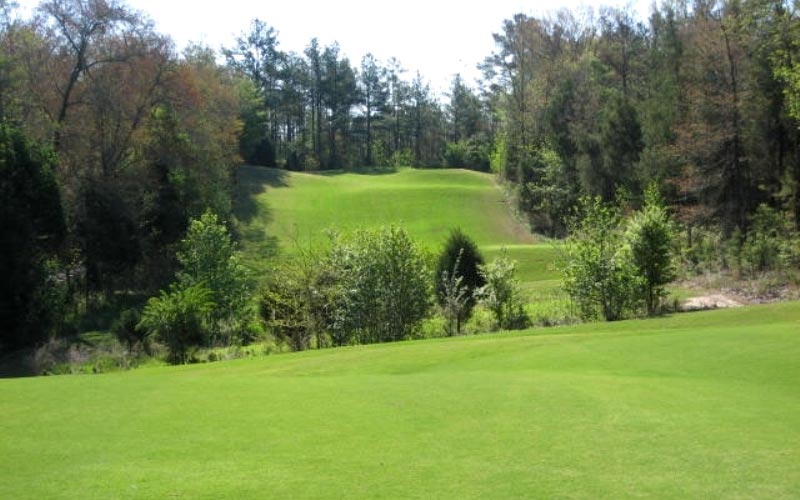
Looking back toward the elevated fourth tee.
Hole 5 414/389/371 yards par four: This is a wonderfully fun hole. The tee box sits some fifty feet above the fairway that is guarded on the right by marsh. The view from the tee is stunning. I will sit on the tee at dusk and watch deer come to drink and wild fowl of all kinds feed in the marsh. Because of the vertical drop the ball seems to linger in space before it begins its descent. Around 200/225 yards off the tee the hole doglegs 90 degrees left. The fairway is massive. You have to really work hard to miss it. Ideally you want to hug the left side of the fairway which will give you only a short iron left to the green. Hit it down the right side and the second shot gets much longer and more difficult. The second shot must carry a sandy waste area to an elevated sloping green. Hit it over the green and pray for the golf gods to smile on the ensuing flop shot.
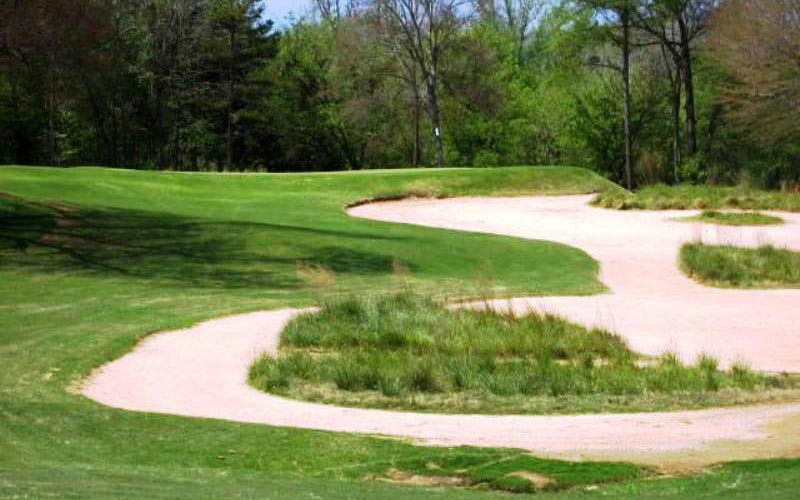
View of shot into the green. The deceptive second shot plays longer than the yardage. I hate to admit how many times the waste area has captured my ball - I've been there so many times I should get squatter's rights.
Hole 6 364/341 yards par four: Musgrove Mill has a superb collection of short par fours. In order to have the shortest shot from the best angle you need to challenge the inside of this dogleg left. A good shot will carom off a hill and leave you with 100-125 yards into the most diabolical green on the course. The green has three levels with the back left shelf the most difficult. Get above the hole and your next shot might be a chip. This is one of my three favorite holes on the course.
Hole 7 189/176 yards par three: Musgrove Mill has four outstanding par threes. Each of them is distinctive. Seven, however, may be the best of the lot. It almost seems as though the land was created to house a golf hole. The Enoree River bends at just the right place. The two tiered green falls off dramatically front, right, and back. Many an elegy consisting of four letter words has been uttered on the walk to the next tee.
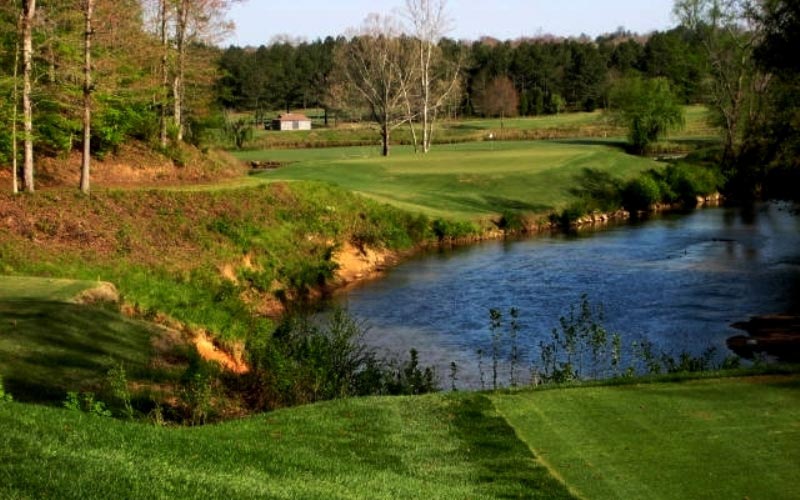
View from the seventh tee.
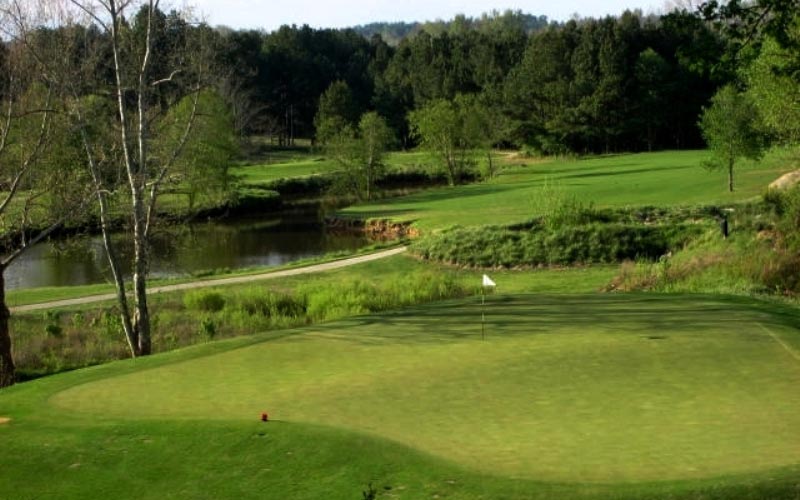
View of the seventh green from above left. The eighth fairway is in the background.
Hole 8 404/384 yards par four: Number eight is a straightforward par four. The tee shot must find the 60 yard wide fairway because there is pond on the left and the river on the right. The second shot is a mid-iron to a large green that abuts the river. Like many of the shots into the green this one calls for about a half club more than you would think necessary.
Hole 9 574/524 yards par five: This is a true three shot par five. It is relatively easy to find this wide fairway, but hit it to far down the left side and all of a sudden you’re reaching into the water for your ball. Depending on your confidence the second shot can be hit up the right side flirting with the marsh. This line gives you the best angle to the green. The left side is the safest place because it gives you some room for error but you are hitting into a canted green where distance control is essential. The green sits twenty feet above the fairway and features three plateaus. The most difficult pin is back right. It is imperative to control the distance of the third shot to avoid another three putt green.
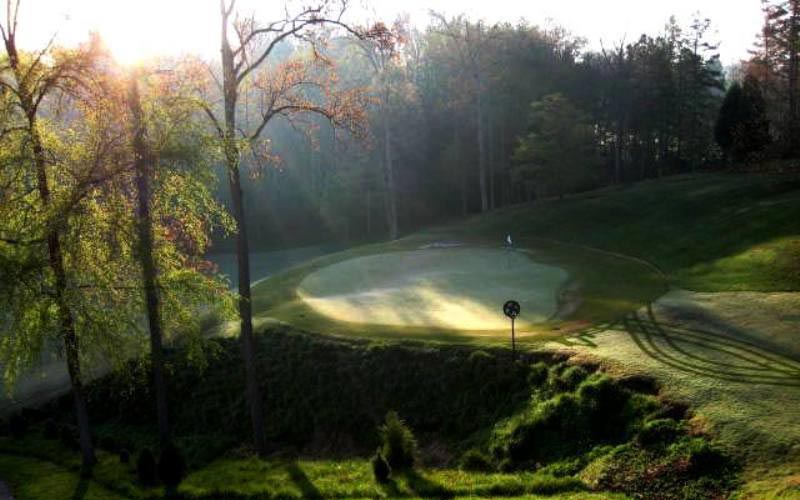
This is a view from the deck of the ninth green.
Hole 10 404/382 yards par four: Number ten is a sharp dogleg left. The tee shot must carry a ravine to a large plateau. From there the player faces a downhill shot to a green that falls off sharply on the left and rear of green. If you keep the ball on the left side of the fairway there is only a short iron left to the green. On the other hand hit the tee ball to the right side of this huge fairway and you have a 180 yard blind shot to the green. The second shot tumbles down a hill to a green that has a dramatic fall off left and back.
Hole 11 355/337 yards par four: This may be my favorite hole on the course. Unless you absolutely fall asleep it is difficult to miss this enormous fairway. On the right side is a hill that kicks any errant tee shot back into the fairway. Most players just try to hit the tee ball about 225 yards. The tee shot is the easy part. It is the second shot that can bring you to grief. It is only a short iron but the green is raised and shallow.
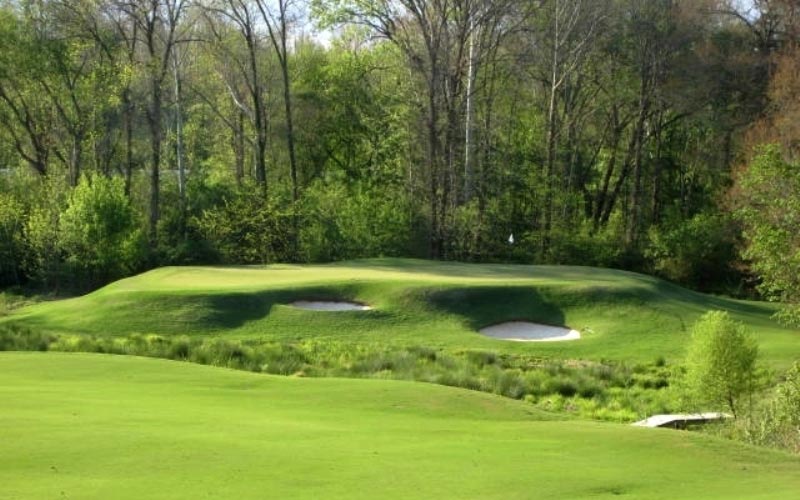
The short, but terrifying, pitch to the well defended eleventh green.
This may be the scariest second shot on the course, even if it is only 100-125 yards long. The easiest pin is on the right side of the green. The left side of the green makes your palms sweat. The green slopes severely from right to left. Too much spin on the second shot will make you wince as you watch you ball run off the green and down the hill.
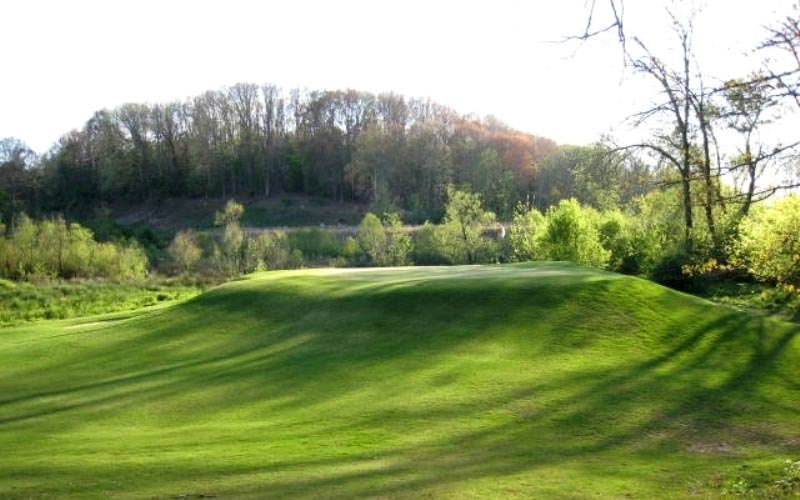
This picture is taken from the right side of the green.
Hole 12 157/145 yards par three: This little hole is thrilling from start to finish. The green is not difficult to hit. Good distance control, however, is imperative. The green is three tiered with a severe slope from back to front. I have seen people four putt and even putt off the green. On the other hand hit the correct tier and a birdie may be in your future. I have made as many birdies as doubles.

A view from the tee box.
Hole 13 568/549 yards par five: This is probably my least favorite hole. Thirteen is a straight forward par five. It is reachable for the longer hitters. The tee shot and lay up do not require much thought. This undulating and quick green is long and doglegs around a sandy waste area. It is the green itself that gives this hole teeth. It takes three shots to get to the green but once there the fun begins.
Hole 14 401/373 yards par four: This is a very demanding hole. A well struck tee shot leaves a middle or short iron into this narrow long green. There is water on the right side of the fairway but a hill on the left side will keep a wayward drive in play. Left of the green is a chipping area. On the right there is a deep sandy waste area and long looms the Enoree River.
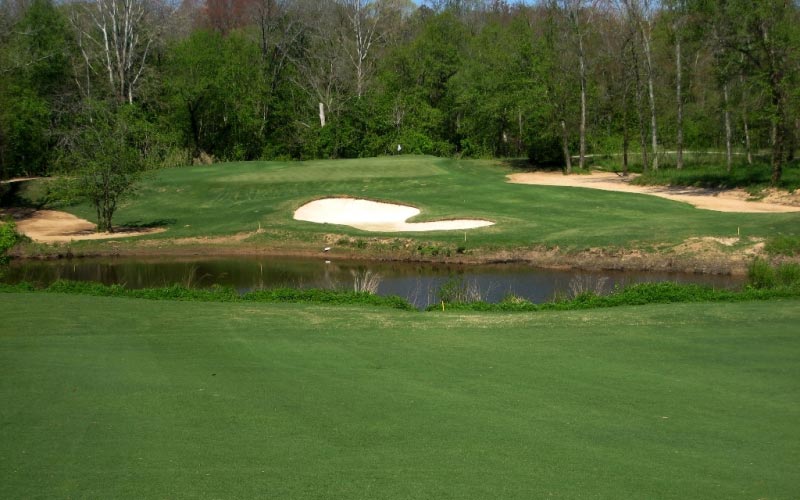
The shot into the green. The most difficult pin placement is back right where the green gets progressively narrower.
Hole 15 373/352 yards par four: Fifteen requires a tee shot of 200/180 yards to be in position to get past the dogleg for a shot into the green. It is not a very demanding hole in terms of drive or even second shot. It is demanding once you get on the green. The very subtle breaks can cause a putt to veer off line considerably.
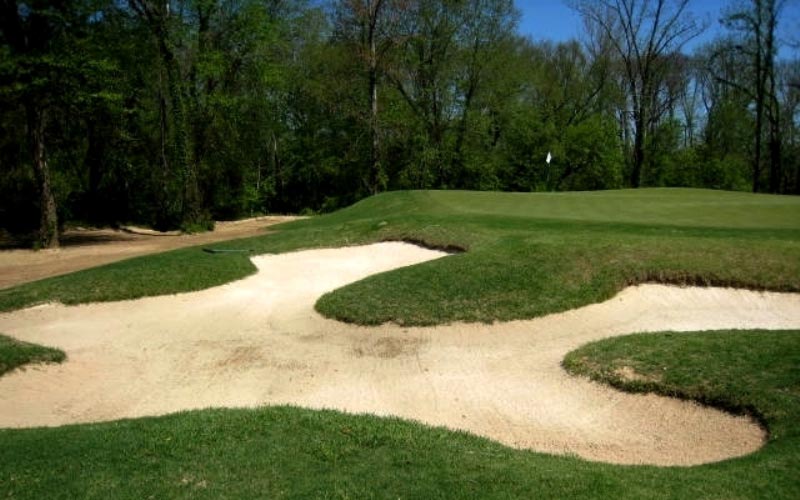
This is the front left bunker. The waste area can be seen on the left and the green's undulations are more evident.
Hole 16 508/485 yards par five: I love this hole. It is a “bite off as much as you dare” slight dogleg left. Depending on skill level or valor, this hole is very reachable in two. The drive must carry the corner of the winding Enoree River. The second shot can trundle along the ground and run up to the narrow opening of the green. However, if you miss to far left you are in the bushes. Miss to the right and you are in a very deep bunker. This hole yields eagles and double bogeys at will. It implores you to go for it. After a good drive it is possible to go for the green. The fairway slants from left to right so a ball hit up the left side will run up onto the green. Hit it too far left and there are bushes and the ubiquitous Enoree River. Miss it right and there is a deep bunker. Up and down out of the bunker depends on the pin placement.
Hole 17 223/203/177 yards par three: This last par three may be the most difficult. It is essential to be on the correct level of this two tiered green. It is uphill to the green but the shot must clear the snaking waste area along the flight path. Getting on the green is only half the battle. Once there you can have a bedeviling putt.
Hole 18 452/421 yards par four: Many a good round has wound up in the purgatory of what might have been. After a good drive you are left with a frightening shot over the snake infested marshland. Guys will sit on the deck and take bets as to who will hit it on the green. Generally the guy who bets against it wins. It is a great finisher. In fact the last three holes are superb finishing holes. Sixteen affords the aggressive player an eagle opportunity. Seventeen demands an exacting tee shot and eighteen tests your nerve. The five, three, four finish sums up the course. The par fives all can be birdied. The par threes are all demanding and the par fours growl until you yield. If you hit a long tee shot you can crest the hill and tumble some thirty-five yards down to the 150 yard marker. Fail and you are left with 175-200 yard shot over perdition.
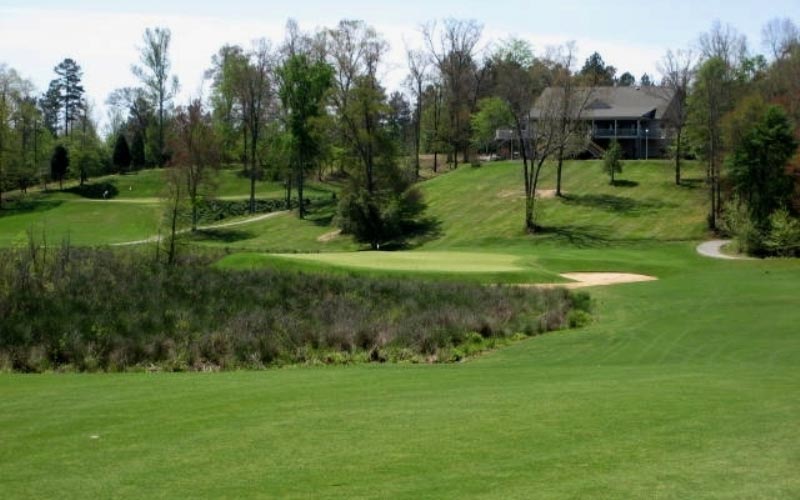
One more iron shot and two putts away from the deck.
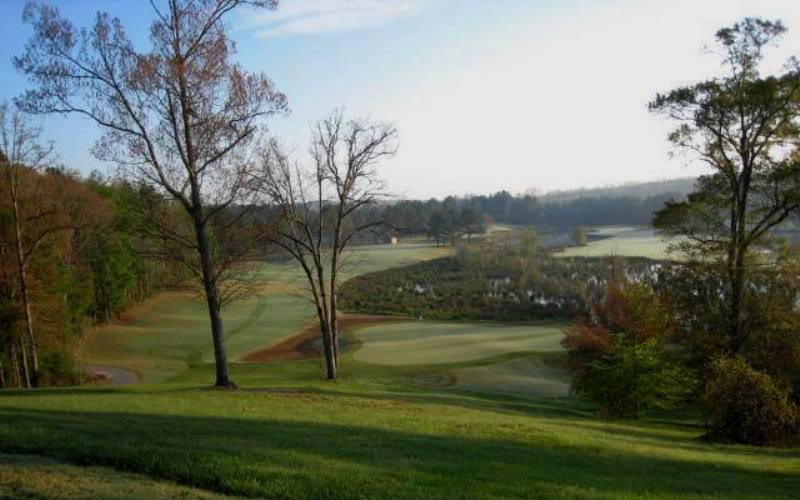
Looking back on the eighteenth.
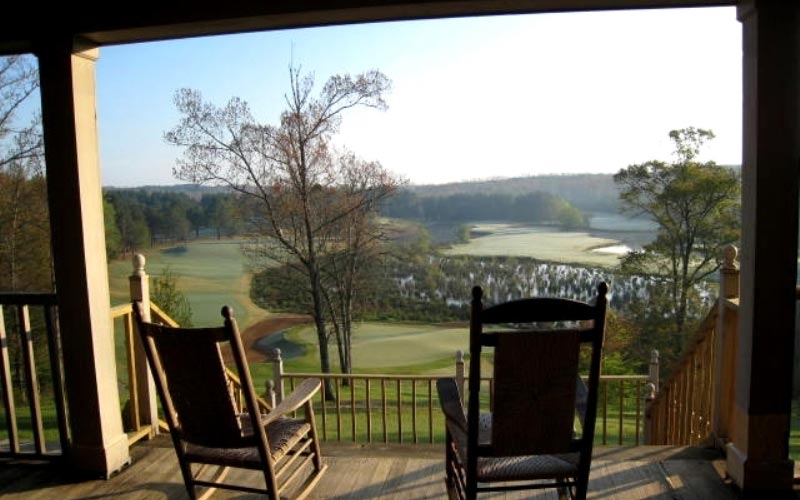
The deck is a great place to unwind!
The End

